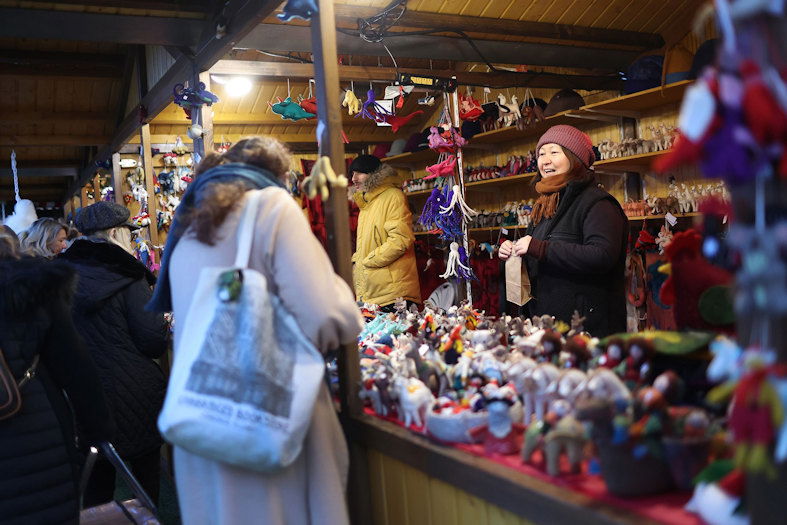Small businesses are hurting at the worst possible time

Washington (CNN) — Enjou Chocolat, a small business in Morristown, New Jersey, is still feeling the pain of inflation these days — from soaring cocoa prices to increased labor expenses.
As a result, the chocolate shop, which employs just under two dozen employees, recently raised the prices of many treats for the third time over the past year. The move was met with customer fury, Mark Chinsky, a partner at the business, told CNN. He said one customer, who had been buying half-pound bags of foil chocolate for years at $10.99, reacted badly to being charged $4 more this time.
“They said ‘that’s just a rip-off, and you’ve lost me as a customer,’ which really hurt to hear,” Chinsky said.
Inflation is down considerably from the 40-year highs seen in 2022, but Americans still have a bitter aftertaste that played a role in handing President-elect Donald Trump a decisive victory over Vice President Kamala Harris in this year’s US presidential election.
Like everyday consumers, small businesses have also felt inflation’s wrath over the years — and they remain angry about it, according to monthly surveys from the National Federation of Independent Business. That’s because small businesses typically having tighter profit margins compared to behemoths like Walmart and Amazon, so they feel the sting of rising costs more acutely. It also means they’re often forced to pass on those costs to the customer.
Having to raise prices couldn’t come at a worse time: The holiday season is a critical period for many of America’s small businesses, but it’s approaching at a time when consumers are feeling more emboldened than ever to push back on higher prices.
The Small Business Index shows that 8 in 10 small retail businesses rely on holiday sales to meet their annual profit goals. According to the NFIB’s latest survey of roughly 1,200 small businesses, a seasonally adjusted 26% of them said in October they plan to hike prices.
“Customers think we’re trying to price gouge them when we’re not, and the question is, will there be enough people continuing to buy at the higher prices to offset the few that now refuse to?” Chinsky said.
America has had it with inflation
It didn’t take long after inflation reached a four-decade high in June 2022 for Americans to begin pushing back on rising prices.
The Federal Reserve’s Beige Book report, a periodic collection of survey responses from businesses across the country, routinely detailed customers questioning price hikes as early as that year. The latest Beige Book continued to tell tales of consumer revolt.
“Frustrated by high prices, they are trading down from beef to chicken, from sit-down restaurants to fast casual, from brand names to private label,” Richmond Fed President Thomas Barkin said in a speech Tuesday. “Price-setters are learning their ability to raise prices is now limited by consumer responses.”
Big box stores like Walmart and Target have announced broad price cuts this year to lure back inflation-weary consumers, with Target saying last month that it is reducing prices for more than 2,000 items for the holiday season.
If only it were that simple for small businesses.
John Waldmann, chief executive of Homebase, a payroll software provider for more than 100,000 small businesses, said Enjou Chocolat’s dilemma is something he hears all the time.
“Small businesses are really reticent to increase prices, so when they do, it’s because they have to,” Waldmann said. “They’re still getting inflation on all sides.”
Ever since inflation took off in 2021, it has consistently been named the top concern among small businesses in the NFIB’s monthly sentiment survey.
“(23%) of owners reported that inflation was their single-most important problem in operating their business (higher input and labor costs), unchanged from September and remaining the top issue,” the NFIB said in its latest release.
Signs of hope for Main Street
Even though customers have grown more intolerant of higher prices, there is optimism that they could still open their wallets this holiday season.
The Conference Board said in a yearly report on holiday spending released Tuesday that the average US consumer plans to spend a nominal $1,063 on holiday-related purchases this year, up 7.9% from 2023 (though after adjusting for inflation, that latest figure was below pre-pandemic levels.) Older and low-income consumers indicated that they’d be cutting back on holiday spending this year, according to the survey.
But will American shoppers flock to mom-and-pop shops that usually can’t afford broad price cuts, unlike big-box retailers?
“While consumers are concerned about some of the inflationary pressures and their holiday budgets, there’s still a real commitment to support local businesses,” said Sarah Jordan, chief marketing officer at Constant Contact, which released a recent survey showing that 78% of more than 3,000 consumers surveyed said they “plan to holiday shop at a small business they have never purchased from before.”
There’s also no sign that the American shopper is cutting back just yet: Fresh government figures released Friday showed that retail spending advanced 0.4% in October, slightly higher than expected, while the September figure was revised up sharply to a robust 0.8% increase from the 0.4% initially reported.
“Ongoing inflationary pressures continue to challenge our Main Streets, but owners remain hopeful as they head toward the holiday season,” Bill Dunkelberg, the NFIB’s chief economist, said in a release.
The-CNN-Wire
™ & © 2024 Cable News Network, Inc., a Warner Bros. Discovery Company. All rights reserved.